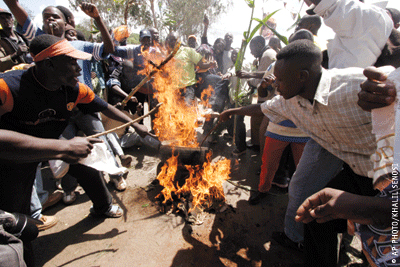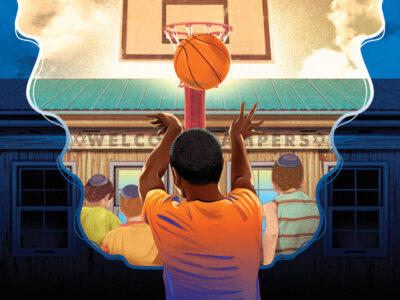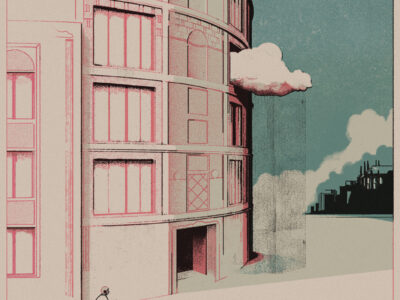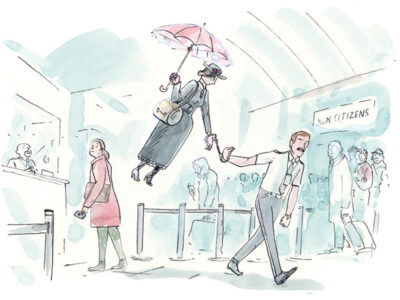
In Kenya, a nurse educator runs up against election violence.
By Sandra Hartnett
The single-propeller plane sputtered to life. “I can’t take all of you and your luggage too,” the bush pilot had said by way of greeting. Now, with most of our suitcases left behind, he shouted over the intercom. “We’re at the top of our weight limit. If I can’t get altitude, I’ll abort the flight and we’ll turn around and get rid of more luggage.” This was not how we had expected to leave Karungu.
Since retiring, I had volunteered four times as a nurse educator at St. Camillus Mission Hospital in Kenya, while my husband taught English and math at the mission primary school. This time we’d come in mid-December, anticipating a four-month stay. St. Camillus provides health care in a poverty-stricken area of Nyanza province, which hugs the shoreline of Lake Victoria in the southwest corner of the country. The hospital has 110 beds and a large HIV/AIDS outpatient program. The mission also provides education and services for orphans. Although the province is inhabited almost entirely by members of the Luo tribe, employment opportunities at the mission have drawn both Luos and others to Karungu.
Shortly after we arrived, campaign workers representing Kenyan president Mwai Kibaki came to a nearby town where support was high for Raila Odinga, a Luo former member of parliament and the strongest opposition candidate. Since the restoration of multi-party democracy in 1992, Kenya’s government has been characterized by the shameless use of patronage. Although many tribes are represented, a lot of high-ranking officials are Kikuyus, who have thrived while many other Kenyans have suffered the effects of corruption, mismanagement, and heavy-handed rule. The 2007 contest, threatening to end 43 years of Kikuyu dominance, was rife with the potential to polarize tribal divisions even further.
Shouting and shoving overtook the Kibaki rally, which ended in the pursuit of the campaign workers by an angry mob. One was killed, others beaten. Police fired their guns to disperse the crowd, and a man was shot. Near death, he was saved by blood transfusions and emergency chest surgery at St. Camillus. The election violence had begun.
Many Kenyans travel to their hometowns to vote. On December 26, one day before the elections, a priest driving three mission employees to nearby Kisii was stopped at a roadblock. Similar barriers, set up by opportunistic young men, would eventually shut down much of the country. Using rocks and clubs, men smashed all the windows and battered the sides of the van. The priest was shoved aside, but the others were robbed and badly beaten.
After the polls closed, people gathered around portable radios. Many candidates on Odinga’s ticket had prevailed, creating the first opposition-party majority. Yet, despite reports of a commanding lead on election night, Odinga did not win. After a suspicious, day-long delay, Kibaki was declared the winner. The looting, burning, and killing began.
As intertribal clashes intensified, the Kenyan countryside came to a standstill. Commercial vehicles were repeatedly attacked. Deliveries of bread, produce, soft drinks, and gasoline ceased. The mission complex continued to function, thanks to large stores of grain and other foodstuffs, adequate pharmacy supplies, and, most importantly, sufficient gasoline to power the generators that supply electricity.
Confined to the compound, our daily life changed from predictable routine to tense uncertainty. Newspapers and mail stopped coming. BBC’s Africa radio service became our main source of information. For three weeks, no bread. Hospital patients received packaged crackers instead to go with their morning tea and porridge. Bored and restless men lingered in groups along the roads. Roadblocks were erected and dismantled.
On December 28, we lost cell phone contact. In the absence of electricity, relay towers in Nyanza province function on gasoline, and gasoline was being held in the eastern port of Mombasa. An inconvenience for us, it became a frightening ordeal for our family. American television showed uncontrolled rampages, including maps singling out parts of southwest Kenya. Our children called everyone they knew with contacts in Kenya, but to no avail. On January 3, an officer at the Catholic Medical Mission Board in Nairobi got through to Karungu. She offered a helicopter rescue just as a mob was stoning the police substation near the hospital. Although we declined, we requested that she contact our son, who notified the others.
Behind the mission fence, a crowd of curious and frightened employees watched the mob activity. A second episode of police shooting had fueled animosity toward the men in uniform, especially those who were not Luo. The shouting grew louder and then—Pop! Pop! Pop! The mob fled and police ran through the village shooting randomly. Four men died and four wounded men came to the surgical ward. That evening the police loaded their equipment onto a truck and left Karungu. With their departure, the violence in our area ended.
As rioting continued elsewhere across the country, we worried about our gasoline supply. We discussed extending the usual morning, midday, and evening electricity blackouts. Drugs and other supplies were getting low. The patient census fell because no one ventured onto the roads except in an emergency.
Families grieved for the dead. One was the only child of an older couple. The HIV/AIDS clinic was empty. Patients who had been instructed never to stop their medications reluctantly went without drugs, afraid to leave their homes. One of the men shot by the police required a third abdominal surgery.
“School will be delayed until the 14th. Supplies have not arrived,” we were initially told, education becoming another casualty of the elections. Then: “Next week for sure.” Finally, “We don’t know when schools will reopen.”
The mission’s security is provided by unarmed guards who patrol the entry gates and the two-mile perimeter at night. Because the violence was intertribal in nature, we hoped the hospital, orphanage, and schools would be unharmed. Still, looking at the dark fields and bushes under the night sky, it was obvious how easily the mission could be overrun. We fell asleep each night hoping we were safe, and awoke each morning relieved.
After the police left, Karungu gradually returned to normal. The hospital census improved and patients crowded the HIV/AIDS clinic. Rain came and, soon after, children with malaria filled the 30-bed pediatric ward.
Continuing education for nurses is a rarity in rural Kenya and my previous classes had been well received, producing the desired result of behavioral change in the nursing staff. Wherever I went, someone asked, “When are the lectures to begin?” But a number of staff members, including the nurse matron, had either not returned from Christmas travel or had fled the area. In the interim, I passed medications, made rounds with the physicians, and worked with the staff on complicated patient situations—functions I would have performed anyway to identify educational priorities. Unable to schedule classes, I revised patient educational materials and nursing procedures. A nurse manager and I planned workshops about post-operative care, obstetric emergencies, and pulmonary assessment.
When the matron returned in late January, we finally planned the first lectures. But three Italian volunteers, scheduled to leave, discovered that all roads between Karungu and the Nairobi airport were unsafe, and likely to remain so. Coincidentally, the Catholic Medical Mission Board had decided to evacuate all of their volunteers. On January 28 they informed us that we were to leave by small plane two days later. In a state of disbelief, our missions unfulfilled, we packed, distributed the toys, textbooks, and other items we had brought, and said our goodbyes.
Our pre-dawn drive to a government airstrip took us over dirt roads largely vacant of vehicles, bicyclists, and walkers. But after one curve, large boulders blocked the way. “We are demonstrating!” shouted a disheveled man as others surrounded the Land Cruiser. Two Luo employees riding with us negotiated our passage for 100 shillings—about $1.40, which wouldn’t quite buy a Tusker beer but might come close to a laborer’s daily wage in Kenya’s many-tiered economy—and a boulder was moved aside.
At the next barricade, a group brandishing tree limbs and metal rods held another car at the side of the road. Two men ransacked the trunk while the occupants watched helplessly. Again, negotiation bought our passage. Looking back, I saw one of the men waving two large fish he’d pulled from the trunk.
To gain as much speed as possible, the pilot taxied beyond the end of the airstrip into an open field before turning and revving the motor. As the plane sped down the runway, I was terrified. “One engine, six people,” I thought. “What if it fails?”
At the end of the runway, shuddering, the plane finally rose and stayed aloft. Below, green countryside gave way to the Maasai Mara National Reserve. A long line of elephants advanced within sight of running wildebeests and hundreds of zebras. Despite the unexpected views of Kenyan wildlife, we were disheartened and subdued.
In Nairobi, a Catholic Medical Mission Board staffer told us, “There are people from four different tribes working here. We are all talking nicely to one another.” But while a more tolerant atmosphere may have prevailed in the capital, the tribes in the countryside plainly were not “talking nicely.” Post-election destruction and population displacements had created enormous problems, and undone years of progress in Kenya.
Our next trip to Karungu will be during a non-election year.
Sandra Hartnett Nu’71 GNu’71 lives in Lawrenceville, New Jersey.




